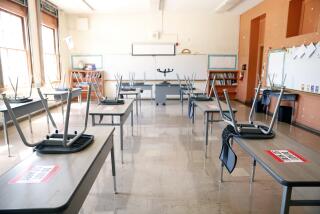Norwalk-La Mirada Interested : Panel Leans Toward Middle School Revival
- Share via
NORWALK — Although wary of the cost, Norwalk-La Mirada school board members appear inclined to revive a middle school system, as recommended this week by an advisory committee.
The middle school movement is “not something that is going to go away,” said board President Jesse M. Luera. “We really have to take a look at it.”
The 26-member committee of parents, teachers and school administrators concluded that the district’s sixth-, seventh- and eighth-graders would be better off in schools of their own.
In recommendations presented to the board Monday night, the committee urged that the Norwalk-La Mirada Unified School District abandon its current system of sending youngsters in kindergarten through seventh grade to elementary schools and those in eighth through 12th grades to high schools.
Suggested Clusters
Instead, the committee suggests clustering kindergartners through fifth-graders in elementaries; sixth-, seventh- and eighth-graders in middle schools, and the remaining four grades in high schools.
After conducting three well-attended public hearings and reviewing state education reports, the committee found “that change was definitely in order,” Richard A. Ruether, committee chairman told the board. Ruether, executive director of the district’s teachers’ union, said that neither the educational nor the social needs of seventh- and eighth-graders are being adequately met by the current arrangement.
The district’s parents are particularly concerned because eighth-graders are attending high schools. “A lot of people don’t want their kids to grow up so fast,” Ruether said.
Indeed, board members say parents’ biggest objections to the present system are social. Board member William Campbell paraphrased their complaints: “My little, sweet daughter is going to high school and those terrible 12th-grade boys are going to ravish her.”
Before the board decides to reopen the middle schools, it must deal with the same issue that forced their closing a decade ago--money. Confronted with declining enrollments, the district in 1978 had to close schools to save money. By phasing out all the middle schools for seventh- and eighth-graders and sending those students to elementaries and high schools, the district was able to keep more high schools and elementaries open. The elementaries and high schools enjoyed the strongest community loyalty.
No ‘Big Uproar’
“There wasn’t any big uproar” over the middle school closings, Campbell recalled.
It will cost an estimated $4 million to $5 million to reopen four to six middle schools, raising the question of where the district is going to find the money. “I’m still concerned about the financing,” said Campbell, who was a district administrator in 1978.
Several options will be examined this summer, including income from the sale of surplus school property. The district will get $9 million from selling the Wright School, one of the closed middle schools. It was demolished last year by a developer who is building a commercial-residential complex on the site.
Although the money has already been earmarked for other uses, such as the construction of a theater at La Mirada High School, board member Sal Ambriz suggests the money should be diverted to the middle schools. The district also owns other surplus sites, including Excelsior High School and some elementaries, which are now being leased for non-district uses.
Ambriz, the board’s strongest middle school advocate, has also proposed that the district levy fees on new commercial development.
Moreover, some of those surplus sites could be used to house the middle schools. District officials say it would not be necessary to build new facilities.
Still, it will require substantial amounts of money to equip the buildings, and to hire extra administrative, clerical and custodial staff. No additional teaching staff would be needed, since the same number of students would be involved.
Board members are already receiving protests from parents and teachers worried that opening middle schools will force the closing of some elementaries or a high school.
“That’s a really good question,” Campbell replied when asked if the board could avoid closings. School closings would would be more likely, he said, if the board created schools for sixth-, seventh- and eighth-graders--as the committee recommended--than if sixth-graders were left in the elementaries.
Ambriz said he was considerably more optimistic that middle schools would return to the district than when he first raised the issue after his election to the board last fall. Nonetheless, he is not ready to claim victory.
“I’m not completely convinced that we’re going in that direction yet,” he said, citing the financial concerns of some board members.
The board is not expected to take any action on the committee recommendations until after the advisory group files its final written report next month.
More to Read
Sign up for Essential California
The most important California stories and recommendations in your inbox every morning.
You may occasionally receive promotional content from the Los Angeles Times.














